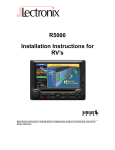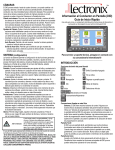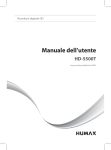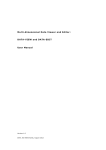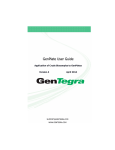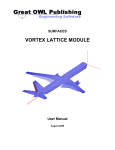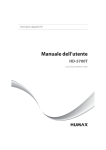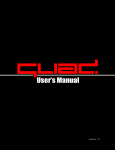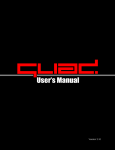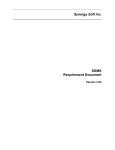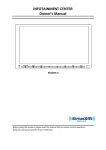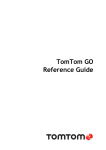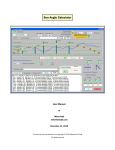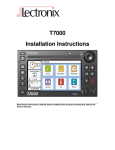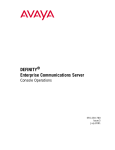Download Users Manual
Transcript
R5000 Operating Instructions Read these instructions carefully before using this product and keep this manual for future reference. © 2006, 2007 Lectronix, Inc. Part Number – 16715-A.2 ii DISCLAIMER THIS IS A DISCLAIMER OF LIABILITY AND DAMAGE RESPONSIBILITY AS REGARDS TO LECTRONIX, INC. AND GARMIN RELATING TO YOUR USE OF THE LECTRONIX R5000 SYSTEM. READ IT CAREFULLY. YOU ASSUME TOTAL RESPONSIBILITY AND RISK FOR USING THIS SYSTEM. Failure to properly focus on the operation of your motor vehicle can result in death, serious injury and property damage. This R5000 device should never be used at a time or in a manner that distracts you from properly focusing on operation of the motor vehicle in which it is installed. Our concern is for your safety. We ask that you fully cooperate with and share that concern. Always operate the vehicle in a safe manner and in full compliance with speed limits, road safety signs and all other laws and devices which regulate operation of a motor vehicle. Be and remain aware of driving conditions at all times when using this system while operating a motor vehicle. Operation of this unit, including its camera, navigation, audio and other features can be distracting to your operation of the motor vehicle. While the system is intended to provide both entertainment and helpful vehicle and navigation information, it is not intended to, nor should you allow it to distract you from properly focusing on operating the motor vehicle in which it is installed. It is up to you to minimize or prevent such distraction. Learn how to use this system before placing the vehicle in operation. Minimize the amount of time spent viewing the screen of the unit while driving and use voice prompts whenever possible. Do not attempt to adjust settings of the system or resolve any malfunction with it while driving. Instead, pull off the road in a safe and legal manner and then adjust its settings or deal with any malfunction. In the event of malfunction, disable the unit (turn power off or remove power from the system). In addition to its multiple other functions, your R5000 system may be equipped with the optional Garmin GVN52 navigation unit. The navigation functions are provided by Garmin and are displayed on the R5000 screen. The use of such navigation functions are the subject of a separate Disclaimer from Garmin contained in the Garmin GVN52 Owner’s Manual made available to you before use. Read that Garmin Disclaimer as it is also applicable to your use of this system. When navigating, carefully compare information displayed on the unit to all available navigation sources, including information from street signs, visual sightings, and maps. Do not enter destinations, change settings or access any functions requiring prolonged use of the controls of the unit while operating your motor vehicle. For safety, pull off the road before making any adjustments to the system or resolving any navigation discrepancies or questions. iii Table of Contents Safety Information ......................................................................................................................... 1 Warnings .................................................................................................................................... 1 Cautions ..................................................................................................................................... 3 Notes on Use: Liquid Crystal Panel ........................................................................................... 3 Getting Started ............................................................................................................................... 4 Understanding Your R5000 ........................................................................................................ 4 Garmin GVN 52 Owner’s Manual ............................................................................................... 4 Satellite Radio User’s Guide ...................................................................................................... 5 Controls, Applications and Functions ......................................................................................... 5 Turning the R5000 On and Off ................................................................................................... 5 Standby Operation ..................................................................................................................... 5 Selecting Applications and Functions ........................................................................................ 6 The R5000 Display ..................................................................................................................... 7 Using the Sound Controls .......................................................................................................... 8 Adjusting Sound Settings ........................................................................................................... 8 Adjusting the Display .................................................................................................................. 9 FM, AM and WB Radio ................................................................................................................ 10 Selecting and Tuning the Radio ............................................................................................... 10 Seek and Scan ......................................................................................................................... 10 Saving and Recalling Radio Stations ....................................................................................... 10 Sirius Satellite Radio ................................................................................................................... 12 Tuning the Satellite Radio ........................................................................................................ 13 Saving and Recalling Satellite Radio Stations ......................................................................... 13 Subscribing to Sirius Satellite Radio ........................................................................................ 13 Parental Lockout and Channel Access .................................................................................... 14 Locking a Channel and setting a Lock Code............................................................................ 14 Unlocking a Channel and removing a Lock Code .................................................................... 15 Accessing a Locked Channel ................................................................................................... 15 Resetting the Lock Code .......................................................................................................... 15 Compact Disc (CD) ...................................................................................................................... 16 Playing CDs .............................................................................................................................. 16 CD Shuffle and Repeat Modes................................................................................................. 17 Playing MP3/WMA files on CD ................................................................................................. 17 USB Audio .................................................................................................................................... 18 Inserting the Memory Stick ....................................................................................................... 18 USB Shuffle and Repeat Modes .............................................................................................. 19 Playing MP3/WMA files on USB............................................................................................... 19 External Audio ............................................................................................................................. 20 Playing Files on Portable Audio Devices (MP3 Players).......................................................... 20 Camera (CAM) .............................................................................................................................. 21 Selecting Cameras ................................................................................................................... 21 Configuring the Camera Options .............................................................................................. 22 iv Vehicle Status (Status) ................................................................................................................ 24 How to View Status Information in a Background Window ...................................................... 25 Alarms........................................................................................................................................... 26 Viewing Alarms ......................................................................................................................... 26 Disabling and Enabling Alarms ................................................................................................ 26 Vehicle Maintenance (Maint) ...................................................................................................... 27 Updating Vehicle Maintenance Information ............................................................................. 27 Trip Statistics (Trip) ..................................................................................................................... 28 Reviewing and Selecting Trip Statistic Items ........................................................................... 28 Operator’s Checklist (Check) ..................................................................................................... 29 Reviewing and Selecting Checklist Items ................................................................................ 29 Clock and Date ............................................................................................................................. 30 Viewing Clock and Date in the Active Window ......................................................................... 30 Setting the Clock and Date....................................................................................................... 31 Tire Pressure Monitor (Tires) ..................................................................................................... 32 Tire Pressure Sensor Operation............................................................................................... 32 Installing Tire Pressure Sensors .............................................................................................. 33 Removing Tire Pressure Sensors ............................................................................................ 34 Replacing Tire Pressure Sensors............................................................................................. 34 Tire Pressure Alarms ................................................................................................................ 34 Navigation (NAV) ......................................................................................................................... 35 Accessing the Navigation MAP ................................................................................................ 35 Configuring Navigation Options................................................................................................ 37 Maintenance ................................................................................................................................. 38 Troubleshooting .......................................................................................................................... 39 If You Suspect Something is Wrong ........................................................................................ 39 Common Problems ................................................................................................................... 39 Appendix A: One Year Limited Warranty .................................................................................. 41 Appendix B: Service and Technical Support............................................................................ 42 Contact Lectronix, Inc. .............................................................................................................. 42 Appendix C: Software Notice ..................................................................................................... 43 Software Notice ........................................................................................................................ 43 Open Source Software ............................................................................................................. 43 Appendix D: R5000 Technical Specifications........................................................................... 44 Technical Performance Specifications ..................................................................................... 45 Appendix E: Tire Pressure Monitoring Option ......................................................................... 47 Sensor Specifications ............................................................................................................... 47 v IMPORTANT SAFETY INFORMATION Safety Information Read the operating instructions for the R5000 and all other components of the system carefully before using the system. They contain instructions about how to use the system in a safe and effective manner. FAILURE TO OBSERVE THE INSTRUCTIONS GIVEN IN THIS MANUAL MAY CAUSE INJURY OR DAMAGE AND VOID THE WARRANTY. This manual uses pictographs to show you how to use the product safely and to alert you to potential dangers resulting from improper connections and operations. The meanings of the pictographs are explained below. It is important that you fully understand the meanings of the pictographs in order to use this manual and the system properly. Warning This pictograph intends to alert you to the presence of important operation instruction and installation instructions. Failure to heed the instructions may result in severe injury or death. Caution This pictograph intends to alert you to the presence of important operation instruction and installation instructions. Failure to heed the instructions may result in injury or material damage. Warning Observe the following warnings when using this unit. Warnings • The driver should neither watch the display nor operate the system while driving. Watching the display or operating the system will distract the driver from looking ahead of the vehicle and can cause accidents. Always stop the vehicle in a safe location and use the parking brake before watching the display or operating the system. • Use the proper power supply. This product is designed for operation with a negative grounded 12 V DC battery system. Never operate this product with other battery systems, especially a 24 V DC battery system. • Protect the deck mechanism. Do not insert any foreign objects into the slot of this unit. • Do not disassemble or modify the unit. Do not disassemble, modify the unit or attempt to repair the product yourself. If the product needs repair, consult your dealer or contact technical support (see Appendix B). • Do not use the unit when it is out of order. If the unit is out of order (no power, no sound) or in an abnormal state (has foreign objects in it, is exposed to water, is smoking, or smells), turn it off immediately and consult your dealer. • Refer installation to qualified personnel. 1 IMPORTANT SAFETY INFORMATION Warning Observe the following warnings when installing. • Disconnect the lead from the negative (–) battery terminal before installation. Wiring and installation with the negative (–) battery terminal connected may cause electrical shock and injury due to a short circuit. Some vehicles equipped with the electrical safety system have specific procedures of battery terminal disconnection. FAILURE TO FOLLOW THIS PROCEDURE MAY LEAD TO THE UNINTENDED ACTIVATION OF THE ELECTRICAL SAFETY SYSTEM RESULTING IN DAMAGE TO THE VEHICLE AND PERSONAL INJURY OR DEATH. • Never use safety-related components for installation, grounding, and other such functions. Do not use safety-related vehicle components (fuel tank, brake, suspension, steering wheel, pedals, airbag, etc.) for wiring or fixing the product or its accessories. • Do not install the product on the air bag cover or in a location where it interferes with airbag operation. • Check for piping, gasoline tank, electric wiring, and other items before installing the product. If you need to open a hole in the vehicle chassis to attach or wire the product, first check where the wire harness, gasoline tank, and electric wiring are located. Then open the hole from outside if possible. • Never install the product in a location where it interferes with the driver’s field of vision. • Never branch the power cord to supply other equipment with power. • After installation and wiring, you should check the normal operation of other electrical equipment. Using electrical equipment that is not operating normally may cause fire, electrical shock or a traffic accident. • In the case of installation to an airbag-equipped vehicle, confirm warnings and cautions of the vehicle manufacturer before installation. • Make sure the leads do not interfere with driving or getting in and out of the vehicle. • Insulate all exposed wires to prevent short-circuiting. 2 IMPORTANT SAFETY INFORMATION Cautions Caution FOLLOW THE LAWS AND REGULATIONS OF YOUR STATE, PROVINCE OR COUNTRY FOR INSTALLATION. Caution THIS PRODUCT IS A CLASS I LASER PRODUCT. USE OF CONTROLS OR ADJUSTMENTS OR PERFORMANCE OF PROCEDURES OTHER THAN THOSE SPECIFIED HEREIN MAY RESULT IN HAZARDOUS RADIATION EXPOSURE. DO NOT OPEN COVERS AND DO NOT REPAIR BY YOURSELF. REFER SERVICING TO QUALIFIED PERSONNEL. Notes on Use: Liquid Crystal Panel • • • • Do not cause impact to the liquid crystal panel. When the temperature is very cold or very hot, the image may appear unclear or may move slowly. In order to protect the liquid crystal panel, keep it out of direct sunlight while the unit is not in use. Sudden changes in the temperature inside the vehicle such as those which occur immediately after the vehicle’s air conditioner or heater has been turned on may cause condensation (droplets of water) to form and, as a result, the panel may not work properly. Do not use the unit while these symptoms are in evidence but leave the unit standing for about an hour, and then resume or start use. 3 INTRODUCTION Getting Started Understanding Your R5000 The R5000 combines radio, CD/MP3 player, rear-view camera system, and advanced engine, coach, and trip monitors into a single integrated system designed specifically for use in Recreational Vehicles. The unit installs easily in the same dashboard space commonly used for existing camera monitors, and replaces three separate systems (camera, radio, and vehicle computer) with one. The R5000 also allows navigation, satellite radio and tire pressure monitoring as options accessible from one common interface. System Overview • Integrated Audio Entertainment, Camera, Vehicle Monitor, and Trip Computer • In-Dash Controller Unit with 7.0” Color TFT LCD Display • CD Reader for Regular and Compressed Audio (MP3/WMA) • Integrated 200W Amplifier for Four (4) Audio Channels at 50W Each • Clock • Video Output (allows screen, any camera, or navigation to be routed to additional monitor) Trip Computer • Multiple Trip Odometers • Speed and Distance Tracking • Fuel Consumption Camera Display • Supports Three (3) Cameras • Automatic Camera Select by Reverse and Turn Indicators • Supports Rear Camera Microphone Expansion Options • Navigation (Video, and Audio)* • Sirius Satellite Radio * † • Audio Input for MP3 Players or other Portable Audio Devices • USB Interface for Future Expansion • Audio Line out (1 stereo) • Video Output (NTSC) • Tire Pressure Monitoring System* Vehicle Monitor • Monitor Coach and Engine Data from Vehicle Busses • Alarms for Fault and Out of Range Conditions • Operator Checklists for RV Arrival, Departure, and Storage Tasks • Maintenance Scheduling & Reminders • Vehicle Bus connections for J1939 Advanced Digital Audio Subsystem • Digital AM / FM / WB Tuner • Satellite Radio Controller (External Tuner Module)* • CD Audio • Compressed Audio (MP3) from CDs & USB Memory Sticks • DSP-based Digital Audio Processing • 5-Band Parametric Equalizer * Some features are optional and may not be installed with your R5000. † A subscription is required to use this service. Garmin GVN 52 Owner’s Manual If your R5000 includes the optional Garmin GVN 52 navigation system, please refer to the Garmin GVN 52 Owner’s Manual included with your vehicle for information regarding the operation of this service. 4 INTRODUCTION Satellite Radio User’s Guide If your R5000 includes the optional Satellite Radio system, please refer to the User’s Manual included with your vehicle for information regarding the operation of this service. Controls, Applications and Functions The front panel controls let you select the R5000’s Applications and Functions. Refer to the following figure to understand how to use the front panels and controls. R5000 Front Panel Buttons & Controls Turning the R5000 On and Off To turn the system on or off, press and hold the rotary dial for about two seconds after the ignition is turned on in your vehicle. When the system turns on, a standard display screen will appear. The R5000 will then automatically transition to the most recent Application and Function. Standby Operation The R5000 will be placed in a standby state for approximately 15 minutes when the vehicle’s ignition key is turned off. When ignition is restored, the system will immediately return to the last Application and Function. After 15 minutes the R5000 will be turned off. 5 INTRODUCTION Selecting Applications and Functions Each Application (i.e., Audio, Camera, Information or Navigation) includes a subgroup of Functions which you select using the Application controls and four-way arrow keys on the front of the R5000. The following table describes the Applications and lists their related Functions. 1) Select an Application by pressing an Application key. 2) To select a Function, continue to press the Application key until the desired Function is highlighted. You can also use the UP and DOWN keys (from the Four Way Arrow group) to select a Function. 3) Press the SEL key to select the Function or wait until the Function is automatically selected. R5000 Applications and Related Functions Application Keys Function AUDIO The R5000 offers a broad range of audio features, including all standard radio bands, along with Weather Band and Satellite Radio. You can play CDs and music files from your USB memory sticks, or use the external function to connect your iPod and MP3 player. The five-band parameter equalizer and DSP-based digital audio processor in combination with a 200W amplifier provide quality sound for long miles on the road. Radio FM Radio AM Radio WB Satellite Radio (if installed) CD USB External (Audio Line In) CAM (Camera) Use the side and rear cameras to avoid accidents and make backing into campsites and driveways fast and easy. The rear camera microphone lets you follow verbal directions from someone guiding you. Rear Camera Left Camera Right Camera INFO (Information) The INFO applications provide you with valuable status and maintenance information about your recreational vehicle. Refer to departure checklists to help you prepare for the next leg of your trip. Update and use the oil change and fluid records to keep up with maintenance. Prevent problems by paying attention to the status alarms alerting you to potential problems with your vehicle. Status Alarm Maint (Maintenance) Trip (Trip Computer Check (Checklist) Clock (Clock and Date) Tires (Tire Pressure Sensor) NAV (Navigation) When configured with the Optional Garmin GVN 52 Navigation system, this selection displays the navigation system information. Optional Navigation System 6 INTRODUCTION The R5000 Display The R5000 display is divided into four windows as shown below. When you select a new Application and Function, the information associated with the current Application and Function may automatically move from the Active Window to the Background or Audio Windows. Application Display Layout 7 INTRODUCTION Using the Sound Controls The sound controls affect the sound source, such as the CD or FM radio. Volume Use the rotary knob to change the volume, regardless of the audio source or Active Application. Turn the knob to the right to increase the volume and left to decrease the volume. A numerical volume number appears in the Audio Window. Muting Audio To mute audio, quickly press the rotary knob. “Mute” will appear in red in the Audio Window. To unmute audio, press the rotary knob again. “Mute” will disappear from the audio window. Equalizer (EQ) To set the Equalizer, repeatedly press the EQ button on the front panel to select one of the seven equalizer selections as listed below: • • • • • Normal (Flat) Country Classical Talk • • Rock Jazz Pop Adjusting Sound Settings You can adjust Sound from any Application. 1) Press the MENU button to access the Sound parameters. 2) Use the LEFT or RIGHT arrow key to select the Sound tab. 3) Use the UP or DOWN arrow key to select the parameter for adjustment. 4) Use the LEFT or RIGHT arrow key to adjust the selected parameter. 5) When finished, press the MENU button again. R5000 Sound Buttons & Controls 8 INTRODUCTION Adjusting the Display You can adjust the Screen from any Application. 1) Press the MENU button to access the screen parameters. 2) Use the LEFT or RIGHT arrow key to select the Screen tab. 3) Use the UP or DOWN arrow key to select the parameter for adjustment. 4) Use the LEFT or RIGHT arrow key to adjust the selected parameter. 5) When finished, press the MENU button again. 6) The R5000 has the ability to output video to an external monitor. The Video Output selection is used to select this output from the following options: • • • Auxiliary (default) – Garmin output if option is installed Main Display Disabled • Rear Camera • Left Camera Right Camera • R5000 Screen Buttons & Controls 9 AUDIO FM, AM and WB Radio The R5000 system’s FM, AM and WB (Weather Band) Radio Functions are selected via the AUDIO button. FM/AM/WB Radio Buttons & Controls Selecting and Tuning the Radio 1) Press the AUDIO button. 2) Press the AUDIO button repeatedly to step through the radio bands. 3) When you reach the desired radio band, either press the SEL button to enable that band or wait until the highlighted option is automatically selected. 4) Use the UP and DOWN keys to tune the radio. 5) Use the LEFT and RIGHT keys to seek or scan to the next station. Seek and Scan 6) To Seek to the next station, press the LEFT or RIGHT arrow key. 7) To Scan stations, press and hold the LEFT or RIGHT arrow key for 2 seconds. The radio will scan to the next available radio station and will pause for approximately 3 seconds before scanning to the next station. To stop scanning, press any arrow key. Saving and Recalling Radio Stations You can easily store (set) and recall your favorite radio and satellite stations using the SEL button. Separate station preset lists are maintained for AM, FM and Satellite Radio. 10 AUDIO To save a radio station - Tune to the radio station and press the SEL button. The preset list will update. To recall a radio station - Press the MINUS (-) or PLUS (+) keys to step through the list of stored radio stations. To remove a station from the preset list - Tune to that station and press the SEL button. The preset list will update. When Empty is displayed, no radio stations are saved. 11 AUDIO Sirius Satellite Radio The R5000 system is compatible with an optional Sirius Satellite Radio. This section describes the features and functions of the Satellite Radio system. Before using the optional Satellite radio, you need to subscribe to the Sirius service either by phone or via the Internet (see Subscribing to Sirius Satellite Radio). SIRIUS Satellite Radio: The Best Radio On Radio With everything from 100% commercial-free music to in-depth sports coverage, plus news, talk and the hottest entertainment – you can always hear exactly what you want. o o o o o o The only home of 100% commercial-free music. Whether you’re discovering new music, or rediscovering songs you haven’t heard in years – you’ll hear it all on SIRIUS. Live play-by-play and expert talk from the biggest leagues. NFL, every game, every week, everywhere. Plus NFL Radio 24/7 news and opinions from top NFL pros, 40 games a week from NBA and College Sports from over 150 schools. Plus NASCAR moving exclusively to SIRIUS in January 2007. Entertainment, Comedy and Talk that can’t be found anywhere else. From 2 channels of Howard Stern, Blue Collar Comedy with Jeff Foxworthy and Larry the Cable Guy to Maxim and Playboy Radio. Especially for Women. Martha Stewart and her team will inspire you 24/7 along with Cosmo Radio, Deepak Chopra Wellness Radio and other exclusive talk show hosts. World Class News, traffic and weather. Fox, CNN, NPR and BBC. Local traffic and weather for the top 20 cities. Family & Kids: G-rated fun for everyone with Radio Disney, Discovery Kids Channel, Laugh Comedy and more. Satellite Radio Buttons & Controls 12 AUDIO Note: The Satellite selection will not be present if the optional Satellite Radio is not connected to the R5000. Tuning the Satellite Radio 1) Press the AUDIO button. 2) Press the AUDIO button until Satellite is highlighted. 3) Either press the SEL button or wait until Satellite is automatically selected. 4) Use the UP and DOWN buttons to select the Music Category. 5) Use the LEFT and RIGHT buttons to select the Music Channel. Note: The signal strength indicator provides an indication of the strength of the satellite signal. Saving and Recalling Satellite Radio Stations You can easily store (set) and recall your favorite radio and satellite stations using the SEL button. Separate station preset lists are maintained for AM, FM and Satellite Radio. To save a radio station. Tune to the category and station of interest. Press the SEL button. The preset list will update. To recall a radio station. Press the PLUS (+) or MINUS (-) keys to step through the list of stored stations. To remove a station from the preset list. Tune to category and station of interest. Press the SEL button. The preset list will update. When Empty is displayed, no radio stations are saved. Subscribing to Sirius Satellite Radio Before you can use the optional Satellite radio, you need to subscribe to the Sirius service either by phone or via the Internet. By phone: 1-888-539-7474. By the Internet: http://www.sirius.com Before activating your service, first: 1) Make sure your SIRIUS tuner is installed with the antenna facing skyward. 2) Tune to “Category – ALL” and to “Channel 184”. Also have on-hand: 1) The System Identification number (SID) from your SIRIUS receiver. This number is located on the Sirius Receiver. It can also be obtained from the Settings screen. Press the MENU key and use the LEFT or RIGHT arrow keys to select the Settings screen. Refer to the SID text for the SID number. 2) A major credit card. Note: Without a subscription, there will be limited Satellite service. 13 AUDIO Parental Lockout and Channel Access Locking a specific satellite radio category and channel will prevent tuning to that particular station. Note: The default Lock Code is 0000. Configuring the Sirius Satellite Radio Locking a Channel and setting a Lock Code 1) Tune the satellite radio to the Category and Channel of interest. 2) Press the MENU key. Press the LEFT or RIGHT arrow key to select the Settings screen. 3) Press the DOWN arrow key to move to the Keypad Display. 4) Press the LEFT and RIGHT arrow keys to move to the first keypad number. Press SEL to enter the number into the Code Display. 5) Continue using the LEFT and RIGHT arrow keys to enter your four-digit code. This code can be any combination of 4 digits. Hint: Choose a code that you will remember. 6) Move to the “S” keypad button and press SEL to set the Channel Lock Code. After the channel has been locked, the channel will appear in the main screen with the “Locked Channel” text displayed. No audio will be heard from the locked channel. Record the Lock Code Here ____ ____ ____ _____ 7) Press MENU to return to the Sirius audio screen. 8) Repeat this procedure to lock additional channels. Note: The same lock code must be used to lock additional channels. 14 AUDIO Unlocking a Channel and removing a Lock Code 1) Tune the satellite radio to the locked Category and Channel. No audio will play and the Locked notification will appear. 2) Press the MENU key. 3) Press the LEFT or RIGHT arrow key to select the Settings screen. 4) Press the DOWN arrow key to move to the keyboard. 5) Enter the Lock code as set in the previous section by pressing the LEFT and RIGHT arrow keys to move to the first keyboard number. Press SEL to enter the number into the Code Display. 6) Continue using the LEFT and RIGHT arrow keys to enter the 4 digit code. 7) Move to the “UL” keypad button and press SEL to unlock the Channel. 8) Press MENU to return to the Sirius audio screen. Accessing a Locked Channel This feature allows access to a channel as needed. Enter the lock code only when the specific channel is active. Once the channel is changed, the channel will stay locked until the lock code is reentered. 1) Tune the satellite radio to the locked Category and Channel. No audio will play and the Locked notification will appear. 2) Press the MENU key. 3) Press the LEFT or RIGHT arrow key to select the Settings screen. 4) Press the DOWN arrow key to move to the keyboard. 5) Enter the Lock code as set in the previous section by pressing the LEFT and RIGHT arrow keys to move to the first keyboard number. Press SEL to enter the number into the Code Display. 6) Continue using the LEFT and RIGHT arrow keys to enter the four-digit code. 7) Move to the “A” keypad button and press SEL to unlock the Channel. 8) Press MENU to return to the Sirius audio screen Resetting the Lock Code To reset the lock code to the factory default of 0000 follow this procedure. 1) Press the Audio button to until Satellite is selected. 2) Once in the Satellite application, press the MENU key to access the satellite menu. 3) Press and hold the DOWN arrow key for 5 seconds. 4) Press MENU to return to the Sirius audio screen 15 AUDIO Compact Disc (CD) The Compact Disk (CD) player is compatible with standard audio CDs as well as audio read/write CDs that include MP3 or WMA files made on your computer. You can play the songs in normal (sequential order) or shuffle mode. CD Playback Buttons & Controls Playing CDs 1) Insert the CD into the CD slot with the text on the CD facing up. When inserted, the audio source automatically changes to CD, and begins playing the first track. You can also select the CD by pressing the AUDIO button repeatedly until CD is highlighted. Press SEL to select the CD or wait and CD will be selected automatically. • • If there is no CD in the system, a reminder to insert a CD will be shown. If there is a CD installed in the system it will start to play. 2) If the CD has music in more than one folder, use the UP and DOWN arrow key to change folders. 3) Use the LEFT and RIGHT arrow keys to move to the next and previous track as well as fast forward and rewind. 4) Press the SEL button to pause and resume CD playback. Caution Inserting foreign objects into the CD slot may cause injury or damage. Do not insert CDs with adhesive labels into the CD slot. 16 AUDIO CD Shuffle and Repeat Modes Shuffle mode plays CD tracks in a random sequence. Repeat mode plays CD tracks from beginning to end of the CD repeatedly. If both are selected, the system will repeatedly play the CD in shuffle mode. 1) Press the MENU button to view the options. 2) Move to the Settings tab with the LEFT or RIGHT arrow key. 3) Use the UP and DOWN arrow key to highlight either the Shuffle or Repeat selection. 4) Press the SEL button to check the desired selection. 5) Press the MENU button again to return to the CD display screen. CD Player Shuffle and Repeat Buttons & Controls Playing MP3/WMA files on CD MP3 (MPEG Audio Layer-3) and WMA (Windows Media™ Audio) are digital audio compression formats. • • • A maximum of 99 folders per CD is supported. Folders may be nested up to this limit. Only a sampling frequency of 44.1 kHz is supported UDF formatted CDs will play, but are not recommended. 17 AUDIO USB Audio The system will automatically detect and play MP3 and WMA encoded music from a USB stick when it is inserted into the system (The system may take a few seconds to recognize the USB stick). The song information associated with each music track will appear on the display screen if it is encoded with the song. USB Audio Buttons & Controls Inserting the Memory Stick Caution Carefully insert the USB Memory stick in the vertical USB port. Do not force the memory stick into the slot. If it does not appear to fit, turn it 180 degrees and try again. Do not insert foreign objects into the USB port. 1) Press AUDIO and USB to play from the USB stick if it is already installed in the system. 2) If the USB stick has music in more than one folder, use the UP and DOWN arrow key to change folders. 3) Use the LEFT and RIGHT arrow keys to move to the next and previous track as well as fast forward and rewind. 18 AUDIO USB Shuffle and Repeat Modes 1) Shuffle mode plays tracks on a random sequence. “Repeat” plays tracks from beginning to end repeatedly. 2) Press the MENU button to view the options. 3) Move to the Settings tab with the LEFT or RIGHT arrow key. 4) Use the UP and DOWN arrow keys to highlight either the Shuffle or Repeat selection. 5) Press the SEL button to check the desired selection. 6) Press the MENU button again to return to the USB display screen. Playing MP3/WMA files on USB MP3 (MPEG Audio Layer-3) and WMA (Windows Media™ Audio) are digital audio compression formats. • • • WMA protected content is not supported. The WMA lossless codec is not supported. Only a sampling frequency of 44.1 kHz is supported. 19 AUDIO External Audio The R5000 will play the audio output from your portable audio devices such as an iPod or MP3 player. External Audio Buttons & Controls Playing Files on Portable Audio Devices (MP3 Players) 1) Connect your MP3 player to the R5000 by cabling the MP3 player to the R5000’s Audio Line In jack. Carefully insert the audio connector into the Audio Line In port on the front of the display. Caution Do not insert foreign objects into the Audio Line In jack. 2) When External is selected from the AUDIO menu, the R5000 will play the audio output from the portable audio device. 20 CAM Camera (CAM) The R5000 supports up to three cameras. Mount the cameras on the vehicle so that there is a left, right and a rear camera. The rear camera supports a microphone that can be automatically activated when the RV is shifted into reverse. Camera (CAM) Buttons & Controls Selecting Cameras 1) To display a camera view on the main window, press the CAM button. 2) Press the CAM button to highlight the camera of interest (Left, Right or Rear). This will define this camera view as the “preferred” camera view. 3) Press the SEL button to display the camera view or wait until the camera is automatically selected. 4) When the preferred camera is viewed, use the LEFT, RIGHT or DOWN arrow keys to provide a quick view of the other cameras. The camera view will display for approximately five seconds after which the camera view will return to the preferred camera view. 21 CAM Configuring the Camera Options When in the CAM view, pressing the MENU button provides a list of camera configuration options. Camera MENU Configuration Options, Buttons & Controls Camera MENU Options Table Menu Option Description Use Camera Audio Turns on the rear camera microphone. Once set, the microphone remains active and will override any entertainment audio sources when the camera view is the active application. Auto Reverse Camera Displays the rear camera view when the vehicle is placed in reverse. Note: If you have selected a preferred camera view other than rear (i.e. left, right), then this auto reverse selection will override your preferred selection and switch to the rear camera view. Auto Reverse Microphone Automatically turns on the microphone for the rear camera when the vehicle is shifted into reverse. Audio from other sources such as Radio, CD, or USB key will be muted when the vehicle is shifted into reverse. 22 CAM Menu Option Description Auto Turn Signal Camera Automatically switches the display to the left or right camera when the left or right turn signal is activated. When the turn signal is deactivated, the camera view returns to the previous application. Note: If Auto Reverse is enabled, then Auto Reverse will take priority over Auto Turn Signal Camera. Default to Camera When enabled the last camera viewed will be restored if there is no activity in another application for approximately 10 seconds. 23 INFO Vehicle Status (Status) The R5000 Vehicle Status display provides information about the operating conditions of the vehicle. The following table describes the information available in the status screens. Screen Status Description Road Traveling information such as road speed, fuel economy, fuel level, average fuel economy, total fuel used, instantaneous fuel rate and total vehicle distance is found here. Engine View engine RPM, oil temperature and pressure, coolant temperature and pressure and transmission oil temperature and pressure in this screen. Electrical Battery voltage and alternator status are available in this screen. Environment Interior and Exterior temperature as well as Barometric pressure and Heading can be viewed in this screen. Miscellaneous Washer Fluid Level and Engine Load can be viewed in this screen. Tire Pressure The pressure of the vehicle tires is displayed. This requires the optional Tire Pressure Sensors. Note: The type and availability of status and alarm information is dependant on the make and model of the recreational vehicle. Vehicle Status Buttons & Controls 24 INFO How to View Status Information in a Background Window You can view one of the fields from the status display in the Background window even when the status display is not the main Application. 1) To select an item for display in the background window. Use the UP and DOWN arrow keys to highlight the status item for display. 2) Press the SEL button to select the item. A check box will appear next to your selection. Selecting a different parameter will remove the previous item from the display. 3) To remove an item from the background window. Move to the selected item and press the SEL button again to uncheck the item. Note: Selecting an item will override the information in the Background window unless there is an Alarm condition. 25 INFO Alarms The R5000 continuously monitors system parameters and presents an alarm when the parameter is outside of normal operating conditions. When there is an alarm, an indicator in a red box appears in the background window, overriding anything that is displayed in that window. You should take note of the alarm and check your vehicle to correct the alarm condition. If there is an Alarm condition, pressing INFO will take you to the Alarm screen. Alarm Indicator Buttons & Controls Viewing Alarms 1) Select the INFO button and scroll to Alarm. 2) Press the SEL button or wait until the Alarm screen is automatically selected. A list of alarms will appear. Disabling and Enabling Alarms 1) When in the Alarm screen, use the UP and DOWN arrow keys to highlight the alarm of interest. 2) Press the MINUS (-) key to disable the Alarm. 3) Press the PLUS (+) key to enable an Alarm. Caution A disabled Alarm will not appear in the Background window. There will be no Alarm notification. The Alarm must be manually enabled to display in the Background window. 26 INFO Vehicle Maintenance (Maint) The Vehicle Maintenance Information helps you track and monitor key vehicle maintenance items. The maintenance item is shown on the left of the window. The Current column displays the number of miles driven since the item received attention. The Sched. column displays the manufacturer’s recommended scheduled maintenance interval. Vehicle Maintenance Buttons & Controls Updating Vehicle Maintenance Information 1) Press the INFO button until Maint is highlighted. 2) Press the SEL button or wait until Maint is automatically selected. 3) Use the UP and DOWN arrow keys to highlight Maint item of interest. 4) To reset an item, press and hold the SEL button. 5) To disable a maintenance item, move to the item of interest and press the MINUS (-) key. 6) To enable a maintenance item, move to the item of interest and press the PLUS (+) key. 7) An alarm will generate if the Current miles driven exceed the Scheduled (Sched.) miles driven. Turn off the alarm by resetting the current value. 27 INFO Trip Statistics (Trip) Trip statistics provide the operator with information while traveling. This information can include, traveling time, gallons of fuel used, average miles per gallon etc. Note: The statistics available depend on the make and model of the recreational vehicle. Trip Statistics Buttons & Controls Reviewing and Selecting Trip Statistic Items 1) Press the INFO button until Trip is highlighted. Press the SEL button or wait until Trip is selected automatically. 2) Use the LEFT and RIGHT arrow keys to select the desired Trip Information page. Trip information is organized into DAY, LEG and TRIP. 3) To view a trip information item in the background window, use the UP and DOWN arrow keys to highlight the Trip item of interest. Press the SEL button to check the item to be displayed. To remove the item from the background window, uncheck the item by pressing the SEL button. 4) To reset trip information, press and hold the SEL button. 28 INFO Operator’s Checklist (Check) The Operator’s Checklist provides the operator with a series of predefined lists to use as a reference for typical procedures including Departure, Arrival, Preparation for Storage and Removal from Storage. Operator Checklist Screen Descriptions Table Screen Description Departure A list of common departure tasks Arrival A list of common arrival tasks Preparation for Storage A list of common tasks to prepare for storage Removal from Storage A list of common tasks for removal from storage Note: The above checklists are a representative list of common tasks and may not include all tasks for your vehicle. Consult your vehicle’s operator’s manual for more information. Operator Checklist Buttons & Controls Reviewing and Selecting Checklist Items 1) Press the INFO button until Check is highlighted. Press the SEL button or wait until Check is selected automatically. 2) Use the LEFT and RIGHT arrow keys to select the desired checklist. 3) Use the UP and DOWN arrow keys to highlight the Check item of interest. Press the SEL button to check or uncheck an item. 4) To uncheck all items, press and hold the SEL button. 29 INFO Clock and Date The R5000’s clock and date are always displayed on the main screen in the lower left hand corner. Clock and Date Buttons & Controls Viewing Clock and Date in the Active Window 1) Press the INFO button until Clock is highlighted. 2) Press the SEL button or wait until Clock is selected automatically. Caution If power is removed from the R5000, the clock and date will need to be reset. 30 INFO Setting the Clock and Date 1) Press the INFO button repeatedly until Clock is highlighted. 2) Press the SEL button to select Clock or wait until clock is automatically selected. 3) Press SEL button to edit the time and date values. 4) Use the LEFT and RIGHT arrow keys to select the field you want to modify. 5) Use the UP and DOWN arrow keys to change the highlighted field 6) When all of the changes have been made, press the SEL button to return to the Clock display. Setting Clock and Date Buttons & Controls 31 INFO Tire Pressure Monitor (Tires) Using the optional tire pressure sensors installed on each tire, the R5000 can monitor the vehicle’s tire pressure and alert you to possible tire pressure problems. Tire Pressure Monitor Controls & Buttons Tire Pressure Sensor Operation Tire pressure is monitored approximately every 5 minutes with sensors placed on each tire. If a low pressure condition exists, the tire pressure is monitored more frequently (approximately every 15 seconds). When there is a tire pressure alarm condition such as low pressure or low sensor battery, an alarm in red will appear on your screen, alerting you to the potential problem. The system generates four different alarm conditions which are described in the following table. Tire Pressure Alarms and Conditions Table Alarm Condition Low pressure Tire pressure is 12.5% below its initial value. PULL OVER, INSPECT TIRE AND REPAIR. Critical low pressure Tire pressure is 25% below its initial value. PULL OVER, INSPECT TIRE AND REPAIR. Missing alarm R5000 has not received a status update from the sensor in the last 15-30 minutes. Low battery Sensor’s battery is low – the sensor should be replaced. 32 INFO Installing Tire Pressure Sensors The sensors determine operating pressure of the tire when the sensor is first installed. Therefore the tire pressure at the time of installation is CRITICAL! All tires MUST be inflated to the manufacturer’s recommended cold pressures while the tires are cold. Refer to the owner’s manual. Caution Install the tire pressure sensors on the tires when they are still cold. Failure to install at this “cold” temperature may cause false alerts. Carefully inspect tires and valve stems prior to installation of the system to ensure that they are in good condition. DEFECTIVE VALVE STEMS MUST BE REPLACED. THE DILL VALVE (small valve inside the valve stem) MUST DEPRESS FULLY AND RELEASE AIR FOR THE SENSOR TO ACTIVATE. The sensor will not activate properly if the dill valve is not the proper length (a common problem). 1) Press the INFO button repeatedly until Tires is highlighted. 2) Press SEL or wait until Tires is automatically selected. 3) Using the FOUR-WAY arrow keys, select the tire to add a tire pressure sensor. 4) Hold SEL until the system prompts you to add a sensor. To abort adding a sensor, tap the SEL button. 5) Screw the tire pressure sensor onto the tire selected. TIGHTEN FIRMLY BY HAND. You should hear the “hiss” of released air when the sensor is being screwed on. Hold the valve stem with your free hand and tighten the sensor securely. Caution Using a tool to tighten the sensor can damage the sensor and nullify the warranty. 6) Wait for system to report new tire added (a green tire icon appears). This can take up to one minute. In the unlikely event that the system has not detected the sensor within one minute after screwing on the sensor, remove the sensor, wait one minute, and then reattach the sensor to tire. (The system can be left in ‘add sensor’ mode during this process.) Repeat this step until the sensor is detected. 7) Repeat steps 1-6 for each tire. After installing the sensors, check for leaks by thoroughly covering the sensor, extension and valve stem with a solution of one part liquid soap to two parts water and look for bubbles indicating a leak. Note: Once a sensor is added to the system, the sensor remains associated with that tire position until deleted, regardless of attachment/removal from the actual tire. 33 INFO Removing Tire Pressure Sensors 1) Press the INFO button repeatedly until Tires is highlighted. 2) Press SEL or wait until Tires is automatically selected. 3) Using the FOUR-WAY arrow keys, select the tire where the tire pressure sensor is to be removed. 4) Hold SEL until the system prompts you to delete a sensor. 5) Use the FOUR-WAY arrow keys to toggle between Yes and No. 6) Press SEL to confirm or cancel the operation. 7) Remove the tire pressure sensor from the selected tire. Replacing Tire Pressure Sensors To replace a tire pressure sensor, the existing tire pressure sensor must be removed from the tire then a new sensor must be added to the tire. 1) Follow the “Remove Tire Pressure Sensors” instructions to remove the current sensor from the tire. 2) Add the new tire pressure sensor by following the “Installing Tire Pressure Sensors’ instructions. Tire Pressure Alarms A red alarm notification will appear in the Background Window if there is a tire pressure alarm condition. If there is an alarm, PULL OVER, INSPECT TIRE AND REPAIR. To view alarm conditions: 1) Press the INFO button repeatedly until Tires is highlighted. 2) Press SEL or wait until Tires is automatically selected. The tires with the alarm condition will be shown in RED. 3) To view the tire pressure use the FOUR-WAY arrow keys to select the tire. The pressure will display will be displayed for the selected tire. To disable and enable an alarm: 1) Press the INFO button until Alarm is highlighted. 2) When in the Alarm screen, use the UP and DOWN arrow keys to highlight the alarm of interest. 3) Press the MINUS (-) key to disable the Alarm. 4) To enable an alarm, press the PLUS (+) key. 34 NAV Navigation (NAV) The R5000 includes support for the optional Garmin GVN52 Navigation system. Please refer to the Garmin User’s Manual included with your RV for information regarding this Application. When navigating, carefully compare information displayed on the unit to all available navigation sources, including information from street signs, visual sightings, and maps. Do not enter destinations, change settings or access any functions requiring prolonged use of the controls of the unit while operating your motor vehicle. For safety, pull off the road before making any adjustments to the system or resolving any navigation discrepancies or questions. Warning You assume total responsibility and risk for using this device. Failure to pay attention to the operation of your vehicle could result in death, serious injury, or property damage. Do not attempt to adjust this device while driving or permit viewing the screen to distract you from safe vehicle operation. Navigation Screen Buttons & Controls Accessing the Navigation MAP 1) Press the NAV button to access the GARMIN navigation system. 2) Use the FOUR-WAY arrow keys to pan around a map. 3) Use the MINUS (-) and PLUS (+) keys to zoom out and into the map. 35 NAV 4) The GARMIN remote control can also be used for navigation. Refer to the GARMIN GVN 52 manual for information on the use of the GARMIN Navigation system. 5) Press the MENU button quickly to access the GARMIN menus. Use the FOUR-WAY arrow keys to move around the GARMIN menus. The menu item will be highlighted when selected. Use SEL to select the highlighted menu. Refer to the GARMIN GVN 52 manual for information on the use of the GARMIN Navigation system. 36 NAV Configuring Navigation Options Navigation options allow you to hear navigation prompts and audio through the R5000. The options are: Route Audio to Main Speakers – Navigation prompts will interrupt current audio source so that navigation prompts can be heard. This would not normally be checked, if the Garmin GVN52 has the external speaker. It would be checked if there is no external speaker attached to the Garmin GVN52. Always Listen – When Navigation is selected as the primary application, Garmin audio is always heard regardless of selected audio application. This is typically used when the Garmin GVN52 unit has XM radio support. 1) Press and hold the MENU button to view the options. 2) Move to the Settings tab with the LEFT or RIGHT arrow key. 3) Use the UP and DOWN arrow key to highlight the option. 4) Press the SEL button to check the desired selection. 5) Press the MENU button again to return Navigation display. 37 Maintenance Your product is designed and manufactured to ensure a minimum of maintenance. Cleaning hints follow. 1) Keep the display clean of dust and debris. 2) Use a dry soft cloth for routine exterior cleaning. Never use benzene, thinner or other solvents. 3) Do not put or spray liquids directly on the screen. Avoid using ammonia-based cleaners and solvents such as acetone. Moisture intrusion into the unit may cause a malfunction. 4) Use a duster or a soft, lint-free cloth (no paper towels) to gently clean the display and front panel controls. When needed, slightly moisten a soft lint-free cloth with water and gently buff the screen. 5) To avoid damaging the unit, do not touch the screen with your fingers or any other items. Do not put pressure on the screen because it could damage it. 6) Avoid spilling liquids or food on the unit, as it may cause the system to malfunction. 38 Troubleshooting If You Suspect Something is Wrong Check and take steps as described below. If the described suggestions do not solve the problem, contact Lectronix, Inc (see Appendix B). Only qualified personnel should service the product. Always refer diagnostics and repair to professionals. Lectronix, Inc. shall not be liable for any accidents arising out of neglect or attempts to repair the unit. Warning Do not use the unit if you suspect faulty operation. Never try to repair the unit by yourself. Common Problems The following tables provide possible solutions to common system problems. Problem Possible Cause Possible Solution No power to the unit The power cord (battery, power and ground) is connected improperly. Check the wiring. No Sound Mute is set to on. Set mute to off. Push the volume knob momentarily. No Sound The speaker lines are not wired correctly, or there is a break or poor contact. Check the wiring in accordance with the wiring diagram. (Installation Instructions) Noise The contact of the ground lead is poor. Make sure that the ground lead is securely connected to an unpainted part of the chassis. Noise is made in step with engine revolutions Alternator noise comes from the vehicle. Change the wiring position of the ground lead. Mount a noise filter on the power supply. Some operations are not executable Some operations are not executable in particular modes such as menu mode. The speaker channels are reversed between right and left The plus and minus terminals at right and left channels of speakers are reversed. Read the operating instructions carefully and cancel the mode. If the unit is still out of order, consult your dealer. Consult the wiring diagram and correct wiring problems. Radio Problems Problem Poor reception or noise Possible Cause Possible Solution Antenna installation or wiring of the antenna cable is faulty. 39 Check whether the antenna mounting position and its wiring are correct. CD Problems Problem Possible Cause Possible Solution No playback The disc is inserted upside down. Insert the disc correctly. No playback There is a flaw or foreign object on the disc. Remove the foreign object, or use a flawless disc. Sound skipping or noise There is a flaw or foreign object on the disc. Remove the foreign object, or use a flawless disc. Playing MP3 / WMA File Problems Table Problem Possible Cause Possible Solution No playback or disc ejected The disc has unplayable formatted data. Refer to the description about MP3/WMA for playable sound data. The CD-R/RWs that are playable on other devices are not playable on this unit The playability of some CDR/RWs may depend on the combination of media, recording software and recorder used even if these CD-R/RWs are playable on other devices such as a PC. Make CD-R/RWs in a different combination of media, recording software and recorder after referring to the description about MP3/WMA. Sound skipping or noise There is a flaw or foreign objects on the disc. Remove the foreign objects, or use a flawless disc Sound skipping or noise Playing VBR (Variable Bit Rate) files may cause sound skipping. Play Non-VBR files. Display Setting Problems Problem Possible Cause The picture is dark. The picture is whitish. Something is wrong with the picture. The picture is light in color. The screen is not adjusted properly. Possible Solution Adjust the display through the MENU option. See the Adjusting the Display section. Sound Problems Problem Possible Cause Possible Solutions No sound from speaker Cables are not connected correctly. Connect the cables correctly. Left and right sounds are reversed The speakers are not connected correctly. Connect the speaker wires to the correct speaker. 40 Appendix A: One Year Limited Warranty This R5000 is warranted to be free from defects in material or workmanship for one year from the date of purchase. During this period, Lectronix, Inc. will replace any R5000 that fail in normal use where used in accordance with this users’ manual. This warranty does not cover failures due to abuse, misuse, improper installation, accident, or unauthorized alteration or repairs. This warranty does not extend to any add-on modules including the Garmin GVN 52 navigation system or the Sirius Satellite Radio. This warranty is for replacement R5000 units only and does not cover any cost of removal of the defective unit or installation of the replacement unit. Replacement units may include rebuilt or refurbished components. THE WARRANTIES AND REMEDIES CONTAINED HEREIN ARE EXCLUSIVE AND IN LIEU 0F ALL OTHER STATUTORY, EXPRESS OR IMPLIED WARRANTIES, INCLUDING WITHOUT LIMITATION, IMPLIED WARRANTIES OF MERCHANTABILITY AND FITNESS FOR A PARTICULAR PURPOSE OR ANY WARRANTY REGARDING THE ACCURACY OF INFORMATIONAL CONTENT INCLUDED OR DISPLAYED BY THE R5000. THIS WARRANTY GIVES YOU SPECIFIC LEGAL RIGHTS, WHICH MAY VARY FROM STATE TO STATE. IN NO EVENT SHALL LECTRONIX OR ITS LICENSORS OR ITS SUPPLIERS BE LIABLE FOR ANY INCIDENTAL, SPECIAL, INDIRECT OR CONSEQUENTIAL DAMAGES, WHETHER RESULTING FROM THE USE, MISUSE, OR INABILITY TO USE THE R5000 OR FROM ANY DEFECTS IN THE PRODUCT. Some states do not allow the exclusion of incidental or consequential damages, so the above limitations may not apply to you. Lectronix retains the exclusive right to replace the R5000 or offer a full refund of the purchase price at its sole discretion. SUCH REMEDY SHALL BE YOUR SOLE AND EXCLUSIVE REMEDY FOR ANY BREACH OF WARRANTY. To obtain warranty service, contact your dealer or alternatively contact Lectronix, Inc. at 1-888423-1183. A copy of the original sales receipt is required as the proof of purchase for warranty services. Lectronix, Inc. 5858 Enterprise Drive Lansing, MI 48911 41 Appendix B: Service and Technical Support There are no user serviceable components within the R5000. Service is provided by Authorized Service providers only. Contact Lectronix, Inc. For help or service, contact Lectronix, Inc. at 1-888-423-1183. When contacting Lectronix, please have the following system information on hand. To obtain the system information: 1) Press the MENU button. 2) Use the LEFT or RIGHT arrow key to select the System Tab. 3) When finished, press the MENU button again The system information screen appears as shown below: R5000 System Information Screen . 42 Appendix C: Software Notice Software Notice The product described in this manual includes copyrighted, patented, or patent pending Lectronix, Inc. and third party software. Laws in the United States and other countries preserve for Lectronix, Inc. and third party software providers certain exclusive rights, such as the rights to distribute or reproduce the software. Accordingly, any protected software contained in the product may not be modified, ported, reverse-engineered, distributed, or reproduced in any manner. Furthermore, the purchase of the product shall not be deemed to grant either directly or by implication, estoppel, or otherwise, any license under the copyrights, patents, or patent applications of Lectronix, Inc. or third party software providers except for the normal, nonexclusive, royalty-free license to use the software that arises by operation of law in the sale of this product. Open Source Software Lectronix uses open source software in the R5000. The open source software used is shown in the following table. Open Source Software Table Package Package Version Provided As License Type ffmpeg Latest Revision in Use source LGPL id3lib 3.8.3 source LGPL u-boot 1.1.1 source GPL zlib 1.1.4 source Custom CD copies of the source code shown in the above table can be obtained by sending a check in the amount of $10.00 payable to Lectronix, Inc to: R5000 Open Source Software Lectronix, Inc. 5858 Enterprise Drive Lansing, Michigan 48911 Make sure you include your return address. Your request will be processed within 8 to 12 weeks. 43 Appendix D: R5000 Technical Specifications The specifications noted herein are subject to change without notice. Rear Panel System Connections NAVION R5000 PWR/SPEAKERS Audio Line Outs TPMS Antenna 16Pin Molex CAMERA INPUTS AM/FM REAR LEFT RIGHT NAV Video Out SDAR Vehicle Input J1939 USB 20Pin Molex External Connections External Connections Audio Out: Speakers Line out Video In: Aux Video Video Out Audio In: Aux Stereo (Two Rear and one Front) Camera Inputs: NTSC with Microphone Vehicle Inputs: Accessory & Ignition Turn Indicators Reverse Transmission Input Information Bus IR Input: Remote Controller (Front) Antenna: AM/FM Radio Antenna TPMS USB: Inputs (One Front, two back) SDAR: Input Four (4) amplified speaker outputs for cockpit One (1) Stereo Pair One (1) NTSC auxiliary composite video input. One (1) NTSC auxiliary composite video output Three (3) stereo aux line inputs. One for satellite radio and one auxiliary on the rear of the unit or one for MP3 players on the front panel. Three (3) NTSC composite camera inputs with one (1) microphone input for the rear camera Input status for key accessory and ignition indications Optional input signal for camera control Optional input signal for camera control J1939 CAN network interface to vehicle information Input IR for system control via remote control Connection for the vehicle AM/FM/WB radio antenna. Connection for the Tire Pressure Monitoring antenna. USB port Version 1.1 (Support for Mass Storage interface) Satellite Radio (SDAR) control and Audio inputs 44 Technical Performance Specifications Power and Grounding Automotive nominal 12 volt, negative ground power. AM Tuner Frequency Range Sensitivity Mechanical Form Factor Main Unit Width 8” Height 6” Depth 6” WB Tuner Frequency Range Environmental Operating range: Storage range: 530-1710 kHz 36.2 dBf (17.7 uV/ 75 ohm) 162.4-162.55 MHz Channel 1 to 7 Sensitivity (20 dB SNR) 19.2 dBf (2.5 uV / 75 ohm) – 10 to 55 °C – 40 to 85 °C Auxiliary Inputs Inputs used for auxiliary expansion including Satellite radio or Navigation Cockpit Audio Speakers • Four outputs for front and rear stereo, each output a separate BTL amplifier • Power output of 22W RMS minimum per channel, into 4 Ohms, all channels driven, at 1 KHz, with 14.4V and no more than 5% THD • Peak Power 50W x 4 • Frequency response 20 to 22,000 Hz at rated power • All outputs fully short-circuit protected (supply, ground, or across load) Aux Stereo Audio • Two (2) stereo audio input pairs • Voltage 5.6 Vpp Aux Video • One (1) NTSC composite video input • Video input level 1 Vpp (75 ohms). Equalizer • Five (5) band parametric equalizer • Preset equalizer curves • Band adjustments +/-12 dB Tone Controls • Bass gain +/- 12 dB • Tone gain +/- 12 dB Radio Tuner FM Tuner Frequency Range 87.7-107.9 MHz Sensitivity (20 dB SNR) 19.2 dBf (2.5 uV/75 ohms) SNR Mono 55.0 dB SNR Stereo 48.0 dB Stereo separation 40.0 dB Distortion Stereo 0.9% 45 Auxiliary Outputs File System Support Outputs used for auxiliary expansion including video monitor expansion and audio to vehicle surround sound. ISO9660 and Joliet CD file systems Audio Digital Formats and Decode Aux Stereo Audio • • Digital audio decoders • • • One (1) stereo audio output pair Voltage 2.8 Vpp Aux Video • • One (1) NTSC composite video Output Video Output level 1 Vpp (75 ohms). Digital audio related formats • • • Camera Inputs • • • • Three (3) NTSC Video One (1) Mono microphone inputs Video level 1 Vpp (75 ohms). Camera Power 8.1V at 150 ma Standard In-Dash Display • • • • • • • • TFT LCD Flat Panel Resolution: 480 x 234 pixels Diagonal size: 7.0 inch Luminance: 400 cd/m2 Response time: 50 msec Contrast ratio: 150 Minimum lamp life: 10,000 hrs Inverter dimming option Optical Disc Media Formats • • • MP3 (32 to 320 kbps and VBR) WMA (48 to 192 kbps) Linear PCM 16-bit 44.1 KHz (Standard audio CD) CD-DA – Red Book CD-R/RW – Orange Book (MP3) CD-I, CD-ROM XA 46 ID3-Tag (v1 and v2) Playlists CD-Text Appendix E: Tire Pressure Monitoring Option The R5000 includes the RF receiver needed to monitor the tire pressure sensors. The setup, control, and monitoring is all done from the R5000 LCD display. Contact Lectronix, Inc. to purchase the optional Tire Pressure monitoring kit (see Appendix B for contact information). The Tire Pressure monitoring kit includes the following: • • • Tire Pressure Sensors (mount to valve stem) Coax wiring and antenna Setup instructions Tire Pressure Sensors Sensor Specifications Pressure Pro Sensor Specifications Sensor Transmit Range Over 100 ft. Line-of-Sight Operating Frequency 433.92 MHz FM Sensor Weight Approx 2/3 oz. Sensor Dimensions 1.011” High x 1.11” Diameter Sensor Battery Internal Non Rechargeable / Non Replaceable Sensor Pressure Range 10 +/-1 psi to 150 +/- 5 psi Sensor Low Voltage Shutdown 2.2 Volts The tire pressure sensors comply with Part 15, Class B of the FCC rules. Any unauthorized changes or modifications to the tire pressure sensors would void the user’s authority to operate the devices. 47






















































